Joint Course of Mapping in Mountainous Area
Maša Arnež1, Dušan Petrovič1, Karel Kriz2, Klemen Kozmus Trajkovski1 |1University of Ljubljana, Faculty of Civil and Geodetic Engineering, Slovenia, 2University of Vienna, Department of Geography and Regional Research, Cartography and GIS, Vienna, Austria
Keywords: joint course, field trip, mountainous area, topography style, open source data
This paper reports on a joint course based on an Agreement of Academic Cooperation between the University of Ljubljana, Faculty of Civil and Geodetic Engineering (UL), and the University of Vienna, Department of Geography and Regional Research (UW). Two elective subjects from master study programs in Geodesy and Geoinformation at UL and Geography at UW were organised as a joint course.
The joint course was organised into three parts. It started with introductory instructions for all 19 registered students and the creation of six groups featuring a mix of nationalities. Each group collected available free data and prepared a topographic map using a different preselected topography
style. Next, was a joint field trip to mountainous area of Velika planina in Slovenia, in May 2017. The students collected additional data missing from the free data sources using GNSS receivers and visual interpretation. This new information was then added to topographic map using established principles of cartographic generalization and map design. After three days of field work and preparing the final map every group prepared a presentation about their work experience, problems, dilemmas, solutions and results. To complete the project, all six maps were merged into one unified topographic map of the selected area. In addditon, the students climbed to the highest point of a plateau, visited a deep cave, tried orienteering, and experienced a drone demonstration. During field trip, all students collected photos and videos for a video blog and web page, which also included all products that were made for the course. The course concluded with every participant giving a short summary of their experience.
All students were very happy with the joint course and learned a lot. The consensus was that universities from different countries should collaborate more often and encourage their students to participate in joint courses.
